人教版七年级英语上册教案:Unit9 第一课时
- 格式:doc
- 大小:63.50 KB
- 文档页数:2
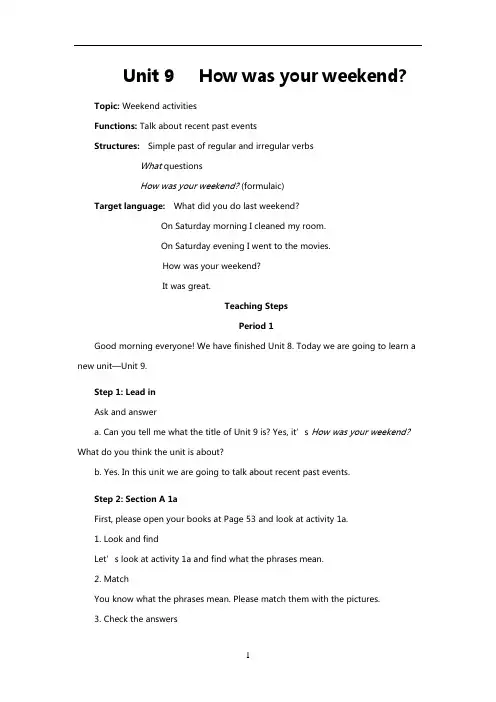
Unit 9 How was your weekend?Topic: Weekend activitiesFunctions: Talk about recent past eventsStructures:Simple past of regular and irregular verbsWhat questionsHow was your weekend? (formulaic)Target language:What did you do last weekend?On Saturday morning I cleaned my room.On Saturday evening I went to the movies.How was your weekend?It was great.Teaching StepsPeriod 1Good morning everyone! We have finished Unit 8. Today we are going to learn a new unit—Unit 9.Step 1: Lead inAsk and answera. Can you tell me what the title of Unit 9 is? Yes, it’s How was your weekend? What do you think the unit is about?b. Yes. In this unit we are going to talk about recent past events.Step 2: Section A 1aFirst, please open your books at Page 53 and look at activity 1a.1. Look and findLet’s look at activity 1a and find what the phrases mean.2. MatchYou know what the phrases mean. Please match them with the pictures.3. Check the answersHave you finished? Let’s check the answers one by one.Answers: 1. d 2. b 3. f 4. c 5. e 6. a4. Reada. Please read the phrases after me. Did my homework …b. Let’s read them together.c. Would you please read them one by one?Step 3: Section A 1b1. Listen and writea. Listen to the tape.b. Let’s write the day and “morning”, “afternoon” or “night” below each picture.2. Check the answersLet’s check the answers.Answers: Picture a: Saturday nightPicture b: Sunday afternoonPicture c: Saturday afternoonPicture d: Sunday nightPicture e: Saturday morningPicture f: Sunday morning3. Reada. I would like you to read the conversation together.b. Would you please read it by yourselves three times?c. This time I would like you to read it twice with your partner.d. Who would like to read in class?Step 4: Section A 1cPairwork1. ReadWould you please read the conversation in 1c with your partner?a. Imagine you are Lucy and your partner is Lucy’s friend. Would you please make conversations with your partner to talk about the activities in the picture?b. Who would like to have a try in class?Step 5: Section A 2a1. ListenNow class, let’s move to activity 2a now. Please listen to the tape for the first time2. UnderlinePlease underline the words you hear when you listen to it for the second time.3. Check the answersHave you finished? Please check your answers with your partner and see whether your answers are the same. Let’s check them together.Answers:Underlined items: grandmother, homework, math, beach, tennisStep 6: Section A 2b1. Listen and writea. Listen to the conversation for the first time.b. Please write “C” for Carol, “B” for Ben or “E” for Emma next to the statements in 2a.2. Check the answersHave you finished? Let’s check them.Answers: 1. E 2. E 3. B 4. C 5. C3. Reada. Let’s read the conversation together.b. I would like you to read it by yourselves.c. Who would like to have a try to read it in class?Step 7: Section A 2ca. Now class, let’s move to activity 2c. Would you please practice the conversation in 2c with the information in the box?b. Who would like to have a try in class?c. Well done. Please pay attention to the past forms of the verbs in the phrases.Step 8: Grammar Focus1. ReadRead the sentences in the grammar box.2. Point out the notesSimple past tense Regular verbs Irregular verbsStep 9: SummarizeLet’s summarize what we learnt in this period.Step 10: Homework1. Copy the words in activity 1a and the sentences in the grammar box.2. Read the tapescript of activity 2a and 2b.Period 2Step 1: Lead inWhat did we learn in Period 1? Who can tell us? Yes.We got to know how to talk about simple past tense. Besides them, we learnt some regular verbs and some irregular verbs. Do you still remember how to say them? OK. Let’s review them first.Step 2: Revision1. Ask and answera. Would you please write down the past forms of following words? 做作业、去海滩……b. Please practice in pairs. Student A says in Chinese and student B translates it into English.2. DictationPlease take out your dictation exercise books and let’s have a dictation.Step 3: Section A 3a1. Complete and numberToday, let’s move to a new part of Unit 9. Would you please look at acti vity 3a on Page 55? Complete the conversation and write numbers from 1 to 3 in the blanks.2. Check the answersI think all of you did well.Answers: 3, 2, 13. Reada. Read it with your partner. If you have any new words, please look them up in the word list or ask me for help.b. I would like you to read it together.c. Would you like to read it in class? Please have a try.4. ExplainHow was your weekend?studied forStep 4: Section A 3bPairworka. Just now, we learnt how to ask about the weekend. Now, I would like you to do a pairwork to ask and answer questions about Ming’s, Tony’s, and Sarah’s weekends from 3a.b. Who would like to have a try in class?Step 5: Section A 4Game—What did you do?Just now, we talked about Ming’s, Tony’s and Sarah’s weekends. How was your weekend? What did you do on your weekend? Let’s play a game guessing what you did. I would like to invite some students to draw pictures of two things you did last weekend. Others guess what you did.Step 6: SummarizeLet’s s ummarize what we learnt in this period.Step 7: HomeworkCopy and try to recite the conversations in 3a.Period 3Step 1: Lead inGood morning, boys and girls. Shall we continue our lessons? Could you please tell me what we learnt in Section A? Yes. We learnt to talk about the weekend.Step 2: RevisionReviewa. I will show you some pictures and please make conversations.b. Let’s have a dictation.Step 3: Section B 1a1. Looka. In Section A, we learnt some verbs and some verb phrases. In Section B, we are going to learn more.b. Open your books at Page 56. Would you please look at activity 1a?c. Look at the words and the pictures.2. MatchPlease match the words with the pictures.3. Check the answersHave you finished, everyone? Let’s check them together.Answers: 1. b 2. d 3. a 4. cStep 4: Section B 1bDrawa. Let’s move to activity 1b. Do you think the activities in 1a are fun or not fun? Draw a happy face or an unhappy face under each picture.b. Would you please tell your partner what you think about them?Step 5: Section B 2a1. Listen and completea. Let’s move to activity 2a now. It is a listening exercise. For the first time, I would like you to listen only.b. Now, for the second time, please listen to it again and complete the chart in activity 2a.2. Check the answersI think most of you have finished it. Let’s check them together.Answers: Sally: cleaned her roomdid her homeworkwent to the libraryJim: played soccerwent to a movievisited his friend3. Read the tapescripta. Let’s read the tapescript together.b. Would you please read the tapescript in pairs?c. Please translate the tapescript into Chinese in pairs.d. Who would like to read in class?Step 6: Section B 2bPairworkSuppose you are Sally and Jim. Would you please talk about your weekend with the information from 2a?Step 7: Section B 2cPair workTask—A surveya. Let’s perform a task now. Six students form a group. Everyone ask others what they did last weekend and fill in the chart.Example: A: What did you do last weekend?B: I did my homework.…b. Give us a short report to tell us what your friends did last weekend.Example: I interviewed some of my friends what they did last weekend. Mary did her homework …Step 8: SummarizeLet’s summarize what we learnt in this period.Step 9: HomeworkPractice activity 2a in Section B.Period 4Step 1: Lead inWe have finished the most part of Unit 9. And in this period, we will continue to finish Section B. But before that, I would like you to review what we learnt before.Step 2: Revision1. Make a speechCan you make a speech to tell us what you did and how your weekend was?2. DictationLet’s have a dictation.Step 3: Section B 3a1. Reada. Let’s go into activity 3a on Page 57. There is an article about kids’ weekend.b. Please read it by yourselves. If you have any questions, please ask me.c. I would like you to read it together.2. UnderlinePlease underline all the past tense verbs in the article.3. Check the answersI think most of you have finished. Please check your answers with your partner.4. ExplainLet me explain some key words and phrases to you.spend for on Saturday afternoon went to sw. watch a movie visit sb. play sportsStep 4: Section B 3b1. Look and fillThere is another article and some pictures. Would you please fill in the blanks according to the pictures given below?2. Check the answersI think most of you have finished it. Let’s check them. Would you please read your article to your friends and see whether your answers are the same.Answers: 1. cleaned my room 2. did my homework 3. visited my aunt4. went to the library5. played soccer6. watched TV3. Reada. Let’s read the article together.b. Please read it by yourselves this time.c. Who would like to have a try to read it in class?Step 5: Section B 3cTask—This was my last weekend.a. Let’s perform a task n ow. Just now, we read two articles in 3a and 3b. Please write your own last weekend. You may follow the examples in 3a and 3b.b. Please share your article about the weekend with your friends.c. I would like to invite some of you to read your article in class.Step 6: Section B 4Game—Who am I?Imagine you are a famous person. Write what you did last weekend. Then talk to your partner about your weekend activities. Your partner tries to guess who you are.Step 7: SummarizeLet’s summarize what we learnt in this period.Step 8: HomeworkTry to recite the article in 3a.Period 5Step 1: Lead inWe have spent four periods on Unit 9. This is the last period of Unit 9. In this period, we will do some exercises and make sure you learn this unit well.Step 2: Self-check-11. Check the words and the phrases you knowOpen your books and look at Self-check-1. If you know the words and the phrases well, please check them.2. ReadI would like all of you to read the words and the phrases together.Step 3: Self-check-21. Do you have any other words you don’t know? Please write them in your exercise books.2. Please ask your friends for help.3. Looking up the dictionary is also a good way to study English. I hope you can get more from dictionaries.Step 4: Self-check-31. Reada. Let’s move to Self-check-3 now. Please read the story about Old Henry by yourselves.b. Who would like to read it in class?2. Writea. Imagine you work for the Heartwarming Project. Would you please write a report about how you helped Old Henry last weekend?b. I would like you to share your report with your partner.c. Who would like to read your report in class?3. ExplainThere are some important phrases and words I would like to explain to you.enjoy go for a walk watch Wang Wang play play with it was time to do sth. look for want to do sth. not … anything Step 5: SummarizeLet’s summarize what we learnt in this period.Step 6: Homework1. Do the exercises on the Studen ts’ Book and the textbook.2. Review Unit 9.3. Watch the pictures in Just for fun on Page 58.人教版七年级英语《Unit 9 How was your weekend?》教案一、教学目标知识目标:学生能够掌握并正确使用一般过去时态的动词形式,包括规则动词和不规则动词的过去式,能够描述过去的活动和事件。
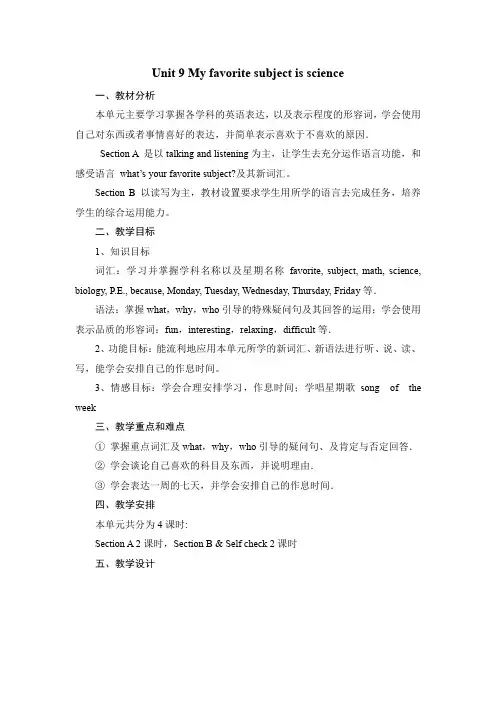
Unit 9 My favorite subject is science一、教材分析本单元主要学习掌握各学科的英语表达,以及表示程度的形容词,学会使用自己对东西或者事情喜好的表达,并简单表示喜欢于不喜欢的原因.Section A 是以talking and listening为主,让学生去充分运作语言功能,和感受语言what’s your favorite subject?及其新词汇。
Section B 以读写为主,教材设置要求学生用所学的语言去完成任务,培养学生的综合运用能力。
二、教学目标1、知识目标词汇:学习并掌握学科名称以及星期名称favorite, subject, math, science, biology, P.E., because, Monday, Tuesday, Wednesday, Thursday, Friday等.语法:掌握what,why,who引导的特殊疑问句及其回答的运用;学会使用表示品质的形容词:fun,interesting,relaxing,difficult等.2、功能目标:能流利地应用本单元所学的新词汇、新语法进行听、说、读、写,能学会安排自己的作息时间。
3、情感目标:学会合理安排学习,作息时间;学唱星期歌song of the week三、教学重点和难点①掌握重点词汇及what,why,who引导的疑问句、及肯定与否定回答.②学会谈论自己喜欢的科目及东西,并说明理由.③学会表达一周的七天,并学会安排自己的作息时间.四、教学安排本单元共分为4课时:Section A 2课时,Section B & Self check 2课时五、教学设计Section APeriod 1Step 1 Warming up and lead in1.用电影Harry Potter预告片作为本课热身,看完之后向学生提问:Do you like the film?然后老师继续表达自己的看法:I like this film best. It’s my favorite movie. What’s your favorite movie?(教师这个时候把这个句型写在黑板上,引起学生的注意。
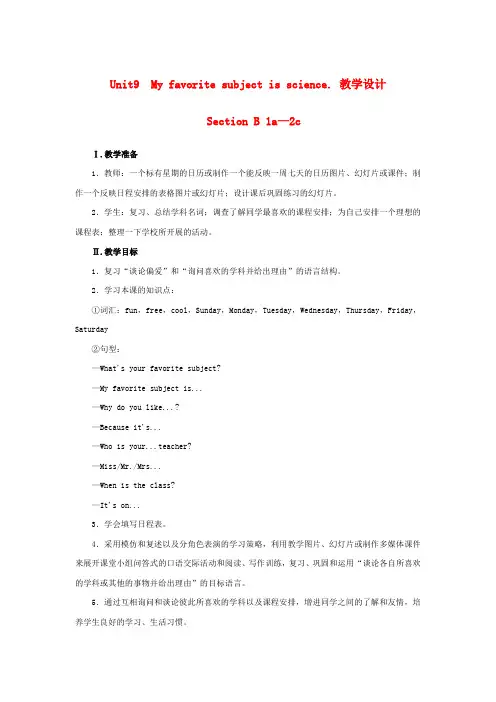
Unit9 My favorite subject is science. 教学设计Section B 1a—2cⅠ.教学准备1.教师:一个标有星期的日历或制作一个能反映一周七天的日历图片、幻灯片或课件;制作一个反映日程安排的表格图片或幻灯片;设计课后巩固练习的幻灯片。
2.学生:复习、总结学科名词;调查了解同学最喜欢的课程安排;为自己安排一个理想的课程表;整理一下学校所开展的活动。
Ⅱ.教学目标1.复习“谈论偏爱”和“询问喜欢的学科并给出理由”的语言结构。
2.学习本课的知识点:①词汇:fun,free,cool,Sunday,Monday,Tuesday,Wednesday,Thursday,Friday,Saturday②句型:—What's your favorite subject?—My favorite subject is...—Why do you like...?—Because it's...—Who is your...teacher?—Miss/Mr./Mrs...—When is the class?—It's on...3.学会填写日程表。
4.采用模仿和复述以及分角色表演的学习策略,利用教学图片、幻灯片或制作多媒体课件来展开课堂小组问答式的口语交际活动和阅读、写作训练,复习、巩固和运用“谈论各自所喜欢的学科或其他的事物并给出理由”的目标语言。
5.通过互相询问和谈论彼此所喜欢的学科以及课程安排,增进同学之间的了解和友情,培养学生良好的学习、生活习惯。
Ⅲ.教学重点学习一周七天的表示方法;复习“询问喜欢的学科并给出理由”的语言结构;提取文章信息填写日程表。
Ⅳ.教学难点what,when,who和why引导的特殊疑问句的使用。
Ⅴ.教学步骤Step 1:Warmup and review1.师生问好。
2.交流与复习。
建议1:头脑风暴利用游戏或者对话活动进行单词或者句子的复习。

Period 2 (Section A 2d-3c)一、教学目标1. 知识目标:(1)掌握单词及短语:Sunday,Monday,Tuesday,Wednesday,Thursday,Friday,Saturday,for sure。
(2)掌握句型:—What’s his/her favorite subject?—His/Her favorite subject is (art).—Why does Bob like (history)?—Because it’s (interesting).—Why do Frank and Bob like (P. E. )?—Because it’s (fun).—Who is your (music)teacher?—My (music)teacher is (Ms. Xie).—When is your (geography)class?—It’s on (Monday and Friday).2. 能力目标:(1)学会使用新词汇和句型谈论自己和同学的学习生活。
(2)能够正确使用下列常用表达:How’s your day?/Who’s your...teacher?/What’s your favorite...?/Because.../That’s for sure.(3)培养学生利用上下文联系法获取相关信息的能力。
3. 情感目标:了解同学喜欢的学科及所喜欢学科的任课老师,增进同学间的友情。
二、教学重点:(1)正确使用疑问词:how,what,why,who,when。
(2)询问并回答对方最喜欢的学科及原因。
三、教学难点:what,why,who,when引导的特殊疑问句的用法。
四、课时安排:1课时五、教学准备:准备一份班级课程表,制作关于一周七天的多媒体课件。
教学过程Step 1Leading inEnjoy the song:Monday,we’ll have a fun day.Tuesday,hear the news day.Wednesday,see some friends day.Half way through a week.Thursday,ˈums and ˈers day.Friday,punch the sky day.Saturday,it won’t matter day.Nearly through the week.When Sunday comes,we can have a rest for one day.If the students can sing,ask them to sing along.Step 2Presentation1. Learn the new words of the seven days in a week. (Sunday是一周的第一天)2. Write the words of the seven days.星期天Sunday 星期一Monday星期二Tuesday 星期三Wednesday星期四Thursday 星期五Friday星期六Saturday3. Have a discussion with the students about their favorite days and subjects.For example:T:What’s your favorite day?S:My favorite day is Monday.T:Why do you like Monday?S:Because I have P. E. and Chinese on Monday.T:What’s your favori te subject?S:My favorite subject is P. E.T:Who is your P. E. teacher?S:Mr. Zhang.Step 3Role-play1. Role-play the conversation in 2d.2. Let the students practice performing the conversation in pairs. Ask some pairs to act it out.3. Discuss the language points.(1)I like...because...意为“我喜欢……因为……”,用来说明对事物的喜好及原因,在口语和书面表达中都经常用到。
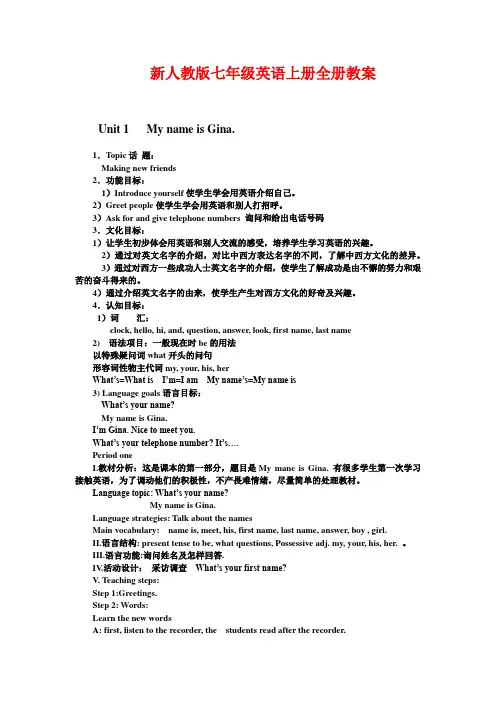
新人教版七年级英语上册全册教案Unit 1 My name is Gina.1.Topic话题:Making new friends2.功能目标:1)Introduce yourself使学生学会用英语介绍自己。
2)Greet people使学生学会用英语和别人打招呼。
3)Ask for and give telephone numbers 询问和给出电话号码3.文化目标:1)让学生初步体会用英语和别人交流的感受,培养学生学习英语的兴趣。
2)通过对英文名字的介绍,对比中西方表达名字的不同,了解中西方文化的差异。
3)通过对西方一些成功人士英文名字的介绍,使学生了解成功是由不懈的努力和艰苦的奋斗得来的。
4)通过介绍英文名字的由来,使学生产生对西方文化的好奇及兴趣。
4.认知目标:1)词汇:clock, hello, hi, and, question, answer, look, first name, last name2) 语法项目:一般现在时be的用法以特殊疑问词what开头的问句形容词性物主代词my, your, his, herWhat‘s=What is I‘m=I am My name‘s=My name is3) Language goals语言目标:What‘s your name?My name is Gina.I‘m Gina. Nice to meet you.What‘s your telephone number? It‘s….Period oneI.教材分析:这是课本的第一部分,题目是My mane is Gina. 有很多学生第一次学习接触英语,为了调动他们的积极性,不产畏难情绪,尽量简单的处理教材。
Language topic: What‘s your name?My name is Gina.Language strategies: Talk about the namesMain vocabulary: name is, meet, his, first name, last name, answer, boy , girl.II.语言结构: present tense to be, what questions, Possessive adj. my, your, his, her. 。
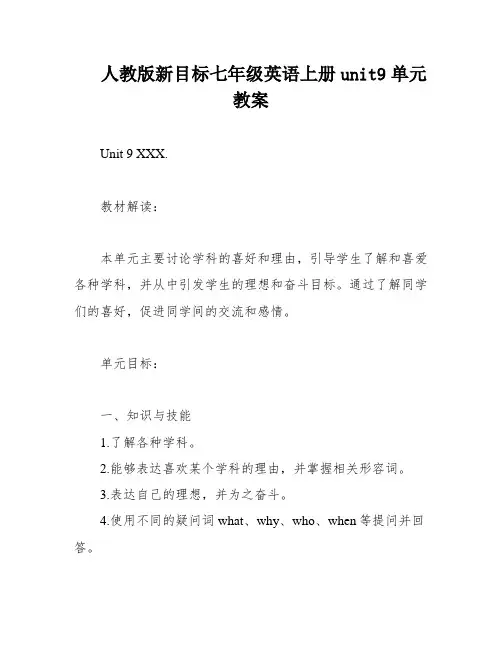
人教版新目标七年级英语上册unit9单元教案Unit 9 XXX.教材解读:本单元主要讨论学科的喜好和理由,引导学生了解和喜爱各种学科,并从中引发学生的理想和奋斗目标。
通过了解同学们的喜好,促进同学间的交流和感情。
单元目标:一、知识与技能1.了解各种学科。
2.能够表达喜欢某个学科的理由,并掌握相关形容词。
3.表达自己的理想,并为之奋斗。
4.使用不同的疑问词what、why、who、when等提问并回答。
5.了解同学们最喜欢的学科,加强同学间的交流,增进感情。
6.培养学生对科学的兴趣,激发学生探究科学的热情。
二、过程与方法观看图片、视频、听录音、对话、表演、游戏、小组活动等。
三、情感态度与价值观通过本单元的研究,培养学生对科学的兴趣,激发学生探究科学的热情。
通过了解同学们最喜欢的学科,加强同学间的交流,增进感情。
教法导航:注重精讲和多练,坚持以学生为主体的原则。
学法导航:多读多思,小组合作研究。
课时安排:第1课时:n A1a-2d第2课时:n A3a-3c第3课时:n B1a-2c第4课时:n B3a-3c第1课时 n A1a-2d教学目标:一、知识与技能1.掌握词汇:1)school .2)形容词:interesting。
relaxing.2.掌握句式:1)——What’s your favorite subject? XXX。
2)——Why do you like。
Because it’s。
3.谈论喜欢的学科并表述理由。
二、过程与方法通过图片和视频激发学生的兴趣和求知欲,引导学生主动探索知识。
三、情感态度与价值观通过互相询问和谈论彼此所喜欢的学科,可以增进同学之间的了解和友情,并培养学生热爱研究、热爱科学的思想和良好的研究、生活惯。
教学重点:1.掌握目标词汇和短语,掌握重点句子。
2.培养学生热爱研究、热爱科学的思想和良好的研究、生活惯。
教学难点:1.主动探索知识,小组讨论疑难点,自主解决。
培养学生热爱研究和科学的思想,以及良好的研究和生活惯是教育的目的。
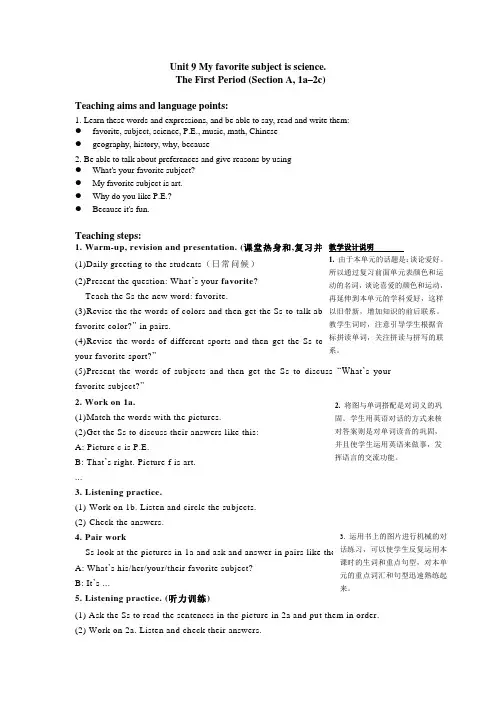
Unit 9 My favorite subject is science. The First Period (Section A, 1a –2c)Teaching aims and language points:1. Learn these words and expressions, and be able to say, read and write them: ● favorite, subject, science, P.E., music, math, Chinese ● geography, history, why, because2. Be able to talk about preferences and give reasons by using ● What's your favorite subject? ● My favorite subject is art. ● Why do you like P.E.? ● Because it's fun.Teaching steps:1. Warm-up, revision and presentation. (课堂热身和,(1)Daily greeting to the students (日常问候) (2)Present the question: What ’s your favorite ?Teach the Ss the new word: favorite. favorite color?” in pairs. (4)Revise the words of different sports and then get the Ss your favorite sport?” (5)Present the words of subjects and then get the Ss to discuss “W hat ’s yourfavorite subject?” 2. Work on 1a.(1)Match the words with the pictures.(2)Get the Ss to discuss their answers like this: A: Picture c is P.E.B: That ’s right. Picture f is art. ...3. Listening practice.(1) Work on 1b. Listen and circle the subjects. (2) Check the answers. 4. Pair workA: What ’s his/her/your/their favorite subject? B: It ’s ...5. Listening practice. (听力训练)(1) Ask the Ss to read the sentences in the picture in 2a and put them in order. (2) Work on 2a. Listen and check their answers.(3) Work on 2b. Listen and match the subjects with the descriptions. (4) Ask the Ss to report their answers like “P.E. is fun .” (5) Explain: Why do you like P.E.? Because it ’s fun. 6. Group work. (小组活动) Interview your group member (1) Make a chart.(2) Ss ask and answer like the conversation in 2c. A: What's your favorite subject? B: Science.A: Why do you like science? B: Because it's interesting.(3) Fill in the chart while talking.7. Homework (家庭作业)1. Remember the new words we learnt today.2. Write a report of your interview.eg. Liu Ming's favorite subject is science. He likes it because it is interesting. ...Unit 9 My favorite subject is science. The Second Period (Section A, 2d –3c)Teaching aims and language points:1. Learn these words and expressions, and be able to say, read and write them: ● Sunday, Monday, Tuesday, Wednesday, Thursday, Friday, Saturday, for sure2. Be able to talk about subjects, schedules and teachers by using ● --How's your day? ● --It's OK.● I like Monday because I have P.E. and history. ● --When do you have P.E.?● --We have P.E. on Monday and Friday. ● --Who's your P.E. teacher? ● --Mr. Hu.● I think history is interesting.That's for sure.Teaching steps:1. Warm-up and revision (课堂热身和复习)4. 进行小组调查就是为了给学生一个语言交际的理由,使学生运用本课时的单词和句型进行有意义有目的的对话。

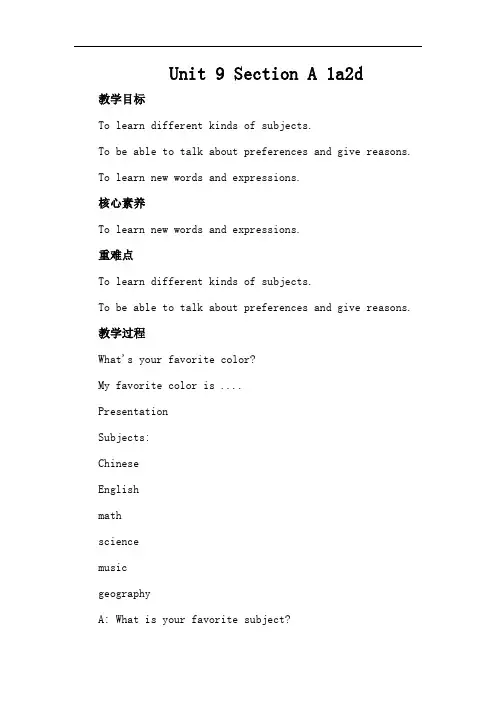
Unit 9 Section A 1a2d教学目标To learn different kinds of subjects.To be able to talk about preferences and give reasons. To learn new words and expressions.核心素养To learn new words and expressions.重难点To learn different kinds of subjects.To be able to talk about preferences and give reasons. 教学过程What's your favorite color?My favorite color is ....PresentationSubjects:ChineseEnglishmathsciencemusicgeographyA: What is your favorite subject?A: How do you spell it?B: …Match the words with the pictures.1. P.E. ___2. art ___3. science ___4. music ___5. math ___6. Chinese ___7. geography __8. history ___Our favorite subjectsA:What’s your favorite subject?B: My favorite subject is _________.I like English best.What’s your favorite subject ?My favorite subject is English.Why do you like English?Because it’s useful and interesting.Practice the conversation with your partner. Then make your own conversations.My favorite subject is art.Look at the picture. What are they talking about?Let's talk about other people's favorite subjectsA:What’s her favorite subject ?B:Her favorite subject is geography.A:What’s his favorite subject ?B:His favorite subject is P.E.ReportAdili’s favorite subject is Chinese. He likes it because it’s relaxing. His Chinese teacher is Mr. Wang. His Chinese class is on Monday .Romaisai’s favorite subject is history. She likes it because it’s interesting. Her history teacher is Miss. Teng. Her history class is on Friday .What do you think of the subjects above? Make your own conversations using the words in 2b.SubjectartsciencemusicP.E.mathgeographyhistoryDescriptionfuninterestingboringdifficultrelaxingWhat’s your favorite subject?Science.Why do you like science?Because it’s interesting.What’s your favorite subject?My favorite subject is ____.Why do you like _____?Because it’s _____. How about you?Read the dialogue in 2d. Then fill in the blanks.1. Bob’s favorite day is ________.2. Bob’s favorite subjects are ______________.3. Bob’s P.E. teacher is _______.4. Frank’s favorite day is _______.5. Bob thinks history is __________.6. Frank thinks history is ________. SummaryQuestio ns How’s your day?What’s your favorite subject? Who’s your favorite teacher? Why? Why do you like…Answers I like…because we have…I like…because it’s…Because …Adjecti vesdays interesting, boring, fun, difficult, easy, r elaxing Monday, Tuesday, Wednesday, Thursday, Friday, Saturday, SundayHomework1. 复习记忆本课所学的生词。
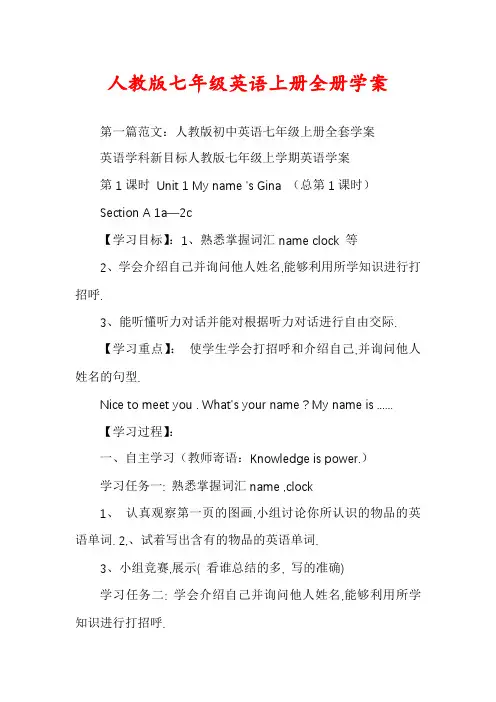
人教版七年级英语上册全册学案第一篇范文:人教版初中英语七年级上册全套学案英语学科新目标人教版七年级上学期英语学案第1课时Unit 1 My name 's Gina (总第1课时)Section A 1a―2c【学习目标】:1、熟悉掌握词汇name clock 等2、学会介绍自己并询问他人姓名,能够利用所学知识进行打招呼.3、能听懂听力对话并能对根据听力对话进行自由交际.【学习重点】:使学生学会打招呼和介绍自己,并询问他人姓名的句型.Nice to meet you . What's your name ? My name is ......【学习过程】:一、自主学习(教师寄语:Knowledge is power.)学习任务一: 熟悉掌握词汇name ,clock1、认真观察第一页的图画,小组讨论你所认识的物品的英语单词. 2,、试着写出含有的物品的英语单词.3、小组竞赛,展示( 看谁总结的多, 写的准确)学习任务二: 学会介绍自己并询问他人姓名,能够利用所学知识进行打招呼.1、教师自我介绍,引导学生介绍自己.A: Hello , I am Gina , What's your name ?B: My name is Alan .2、小组竞赛, 两人一组,询问他人姓名,介绍自己.3,、分角色朗读1A对话.学习任务三: 能听懂听力对话并能对根据听力对话进行自由交际.1,、听录音, 给1B 的对话编号.2、根据听力对话进行自由交际.3、小组竞赛, 展示对话交际。
二、合作共建(教师寄语:Many hands make light work. )小组讨论我们所学的英语名字和汉语名字的区别, 如何用英语拼写你的名字?三、系统总结(教师寄语:No man can do two things at once.)1,、归纳你所学到的问候语.2、自己编写一个打招呼并询问姓名的小对话.四、诊断评价(一)单项选择.1. _______your name ? My name is Gina .A. WhatB. What'sC. WhoD. which2. Good morning , Miss Wang ! _____________!A. HelloB.HiC. Nice to meet youD. Good morning3. I _______Sally , What______ your name ?A. am ,isB. is , amC. is , isD.am, am4. ______name is Li lei .A. IB. I amC. MyD. you5.― _______, What's your name ?― John Green .A. HiB. OkC. sorryD. Excuse me(二)写出下列单词的完全形式, 并写出汉语意思.I'm _________ __________ what's __________ ________name 's ___________ __________(三)写出下列单词.时钟_______ 我的________ 你的___________ 名字_______ 遇见_________(四)尝试翻译下列句子.1. 见到你很高兴. _________________________________.2.我叫王小雨. ____________________________________.3. 你叫什么名字? ____________________________________(五)根据情景补全对话.A: Good afternoon !B: ____________________!A; I ______Lucy . _________your name ?B: My ______ is Jim . Nice to ______you !A: _______________________________.五、【课后反思】(教师寄语:Never do things by halves)第2课时Unit 1 My name 's Gina.(总第2课时)Section A (1a―2c)【学习目标】:1、熟练掌握本课6个单词.2、学会询问他人姓名及介绍他人姓名.3、能听懂有关谈论他人姓名的对话并进行自由交际. 【学习重点】:询问他人姓名及介绍他人姓名的句型. 一、自主学习(教师寄语:Knowledge is power.)学习任务一: 熟练读写本课6个单词.1.个人自渎,记忆本课单词.2.小组互相检查单词读写情况.3.根据汉语写出下列英语单词并展示.学习任务二: 运用句型:What's his / her name?His / Her name is .... 进行自由交际.1.小组合作,理解并熟读下列短语,并写出汉语意思.my nane ( )your name ( )his name ( )her name ( )2.个人理解下列对话,并且两人合作练习.A:Hello! What's your name?B:My name is Gina.A:Nice to meet you.B:Nice to meet you,too.A:What's her name?B:Her name is Jenny.3.小组合作,练习自己的对话.4. 对抗组开展竞赛,展示自己的对话.学习任务三: 听听力完成2a,2b.1.个人看图,理解四幅图画,思考图画中人是在谈论他人还是对方.2.听听力,给四幅图画编号.3. 小组为单位,熟读2b中的名字。
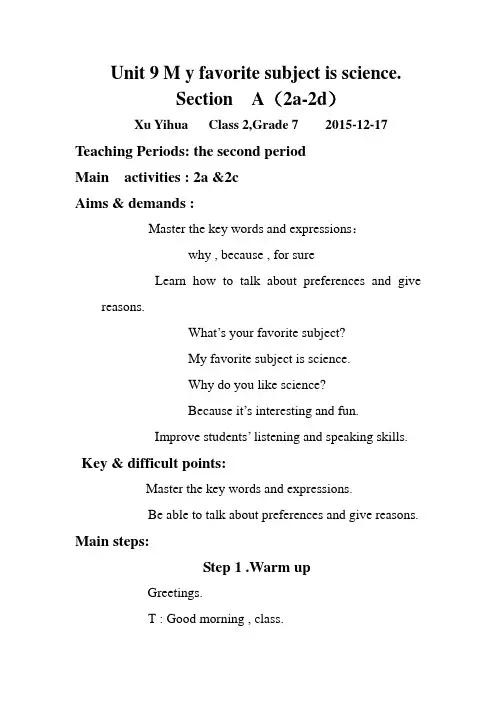
Unit 9 M y favorite subject is science.Section A(2a-2d)Xu Yihua Class 2,Grade 7 2015-12-17 Teaching Periods: the second periodMain activities : 2a &2cAims & demands :Master the key words and expressions:why , because , for sureLearn how to talk about preferences and give reasons.What’s your favorite subject?My favorite subject is science.Why do you like science?Because it’s interesting and fun.Improve students’ listening and speaking skills. Key & difficult points:Master the key words and expressions.Be able to talk about preferences and give reasons. Main steps:Step 1 .Warm upGreetings.T : Good morning , class.Ss :Good morning , teacher.T : Nice to meet you .Ss: Nice to meet you , too.Check the homework.Revise the words about the subjects.Step 2 . PresentionFirst, lead students to read the four sentences and tell them that these sentences are in a wrong order.If they are in a correct order,they’ll make a conversation.Play the recording for the first time.Students listen and finish the work.Then play it for a second time and check the answer.Step 3 . PracticeFirst, ask the students to read the sample conversation in 2c so that they can know how to do this activity.Then, get students to make conversations using the information in 2b.Give them five minutes to prepare it.Step 4 . ConsolidationGive students four minutes to read through the conversations in 2d silently so that they can get the main idea.The teacher reads the conversation,have students repeat sentence by sentence, and explain the meanings at thesame time.Divide the students into two groups to role-play the conversation in turn.The teacher can encourage students to make their own conversations by substituting the key words.Later ,leave students enough time to role-play the conversations in pairs.Step 5 . SummaryI n this period, we’ve learned how to talk about preferences and give reasons . And we’ve also learned some subjects and descriptive words.Step 6 . HomeworkCopy the words about subjects and try to recite them.Practice reading the conversations in 2d and make your own conversation.。
七年级英语上册全英文教案(全册)Unit 1 My name's Gina.一、单元教材分析本单元围绕“结交新朋友”使学生学会打招呼和介绍自己、询问他人姓名的基本句型:“What’s your/his/her name?My/His/Her name is …”; 通过学习区分"First/last name”,了解有关姓名的文化知识;通过查询电话号码“What’s your/her/his phone number?”,学习数字1~9,同时也进一步促进学生之间的相互了解;通过以上几个方面的学习,使学生在轻松、愉快的学习氛围中熟识新伙伴。
本单元与第二单元衔接紧密:由课堂内的打招呼、自我介绍到课外、校外相互了解。
由特殊疑问句的学习到一般疑问句的学习,使学生将书本知识运用到实际生活中。
二、单元学情分析本单元的主题是熟识新伙伴,同时引导学生采用Practicing, Listening for specific information和Role playing的学习策略,学习一些新词汇,掌握一些重点句型,在小组合作学习的过程中,进一步促进学生之间的相互了解。
三、单元教学建议本单元可综合运用讲授式、启发式、自主学习、合作学习等各种策略,提供大量的学习资源,通过老师向学生进行的自我介绍,同学自我介绍传句子比赛,自我查资料表演,自制明信片等的活动,使学生能够学到知识,又增加了他们的学习的乐趣。
来培养学生的自主学习的能力及表达能力和逻辑思维能力。
采用Practicing, Listening for specific information和Role playing的学习策略,利用教学图片或制作多媒体课件来展开课堂Pair work, Group work的口语交际活动,询问他人姓名、查询电话号码,了解有关姓名的文化知识。
四、单元课时分配本单元可用4课时完成教学任务:Section A (1a-2d) 用1课时Section A (Grammar Focus-3c) 用1课时Section B (1a-2c) 用1课时Section B (3a-Self Check) 用1课时Section A (1a-2d)一、教学目标:1. 语言知识目标:1) 能掌握以下单词:name nice meet his and her your能掌握以下句型:① —Hi. My name’s Gina. —I’m Jenny. Nice to meet you!① —What’s your/his/her name? —My/his her name is…① —Are you…? —Yes, I am. / No, I'm not.① —Is he/she…? —Yes, she/he is. / No, she/he isn’t.2) 能了解以下语法:your, his, her等形容词性物主代词的简单用法;What’s=what is I’m=I am name’s=name is等缩写形式。
七年级上册教案Starter Unit 1 Good morning !教学重点:Aa --- Hh的字母教学。
Hello! Good morning. Good afternoon. Good evening.-- How are you? -- I’m fine, thanks. And you? -- I’m OK.教学难点:课本中英语人名的学习和大、小写字母的学习及书写。
单元课时:5个课时第一课时:完成Section A 1a, 1b第二课时;完成Section A 2a, 2b,2c, 2d, 3, 4a第三课时:完成Section A 4b, 4c, Section B 1, 2a, 2b第四课时:完成Section B 3a, 3b, 4, 5第五课时:完成Self Check and Just for Fun教学目标:A. 语言知识目标词汇:Letters Aa --- Hh八个人名:Alice, Bob, Cindy, Dale, Eric, Frank, Grace, Helen句型:Good morning. Good afternoon. Good evening.-- How are you? -- I’m fine, thanks. And you? -- I’m OK.B. 语言技能目标通过游戏等多种形式的学习活动,培养学生对初学知识的听、说、读、写能力和灵活运用初学的日常交际用语的能力。
C. 情感目标1. 激发学生学习英语的兴趣,发挥学生学习英语的积极性和主动性。
2.通过小组活动,培养学生的合作意识和团队精神。
3.在活动中培养学生的思维能力和创新能力。
Period OneTeaching materials:Section A 1a,1bTeaching aims:1.识别和掌握八个人名。
2.学会早上见面打招呼的用语。
Language points1.词汇:Alice, Bob, Cindy, Dale, Eric, Frank, Grace, Helen2.句型:Hello! Good morning!Difficulties:八个人名的掌握Teaching procedures:Step 1. Warming-up1.T wears a name card with an English name on it, then points to the name card and have an introduction.2. Greet the whole class and help them to say, Hello, … Good morning, …Step 2. Play a game.T gets ready for a list of English names for boys and girls.Play the game like this:T says a letter, for example C, then let the Ss tell the letters which is before and after C. The one who says B, D first is the winner. The winner can get a chance to choose an English name first or he can give the chance to his friend.Step 3. PresentationShow a picture of a girl and give the name under the picture, teach Alice. In the same way teach the other seven names.Step 4.GameShow the pictures of these eight children as quickly as possible. Let the Ss tell the names of these children. ( The winner can have a chance to choose an English name.)Step 5. PresentationShow a picture with Eric, let Ss guess what Eric wants to say to us. The answer is : Hello! or Good morning. Then help them to say: Hello, Eric! or Good morning, Eric.Step 6. Work on 1aPlay the recording for the first time, Ss only listen.Play the recording a second time. Ss repeat.Step 7. Work on 1bSs practice the conversations in pairs. T moves around the classroom when Ss are practicing. Give them some help if needed.Ask Ss to practice greeting each other. They can use their Chinese names if they wish. Encourage them to use their English names if they can. Ask them to practice using all the different greetings taught in Activity 1a. HomeworkMake a name card like the teacher’s by themselves and learn how to read their own names.Period TwoTeaching materials:Section A2a-4aTeaching aims:1.学会正确朗读和书写Aa-Hh八个字母。
Unit 9 My favorite subject is science学情分析:本单元是人教版新目标英语七年级上册第九单元,也是最后一个单元。
主要围绕“School subjects”这个话题展开讨论,并懂得询问和回答最喜欢的学科和喜欢的原因,以及星期的表达.学生学过了八个单元的新目标英语,对整个课程的教学模式有了一定的了解,具备一定的听、说、读、写的基础.对于特殊疑问句的句型和相关的形容词及日期的表达已经有所接触,为本单元的学科和星期的表达打下了基础。
通过本单元的进一步学习,使学生能够更加熟练地运用目标语言进行交际活动.教材分析:Unit 9 以“School subject”为话题,选材于学生的日常生活,十分符合学生实际。
七年级的学生开始学习各种科目:语文、数学、英语、生物、历史、地理、美术、音乐等。
学习生活有了紧凑的安排,每天的课程都排得满满的.他们也一定会有自己喜欢的科目,有自己的学习计划。
通过讨论学习,能够提高他们的学习兴趣,进行合理的学习安排.Section A 主要通过听、说和讨论的活动让学生了解怎样用英语询问和回答最喜欢的学科和喜欢的原因,以及这些学科的课任老师。
并学会用fun,interesting,boring,difficult,relaxing等形容词来表达自己喜欢某个学科的原因。
学会新词汇和用特殊疑问句What’s your favorite subject。
Why do you like...? Who is your .。
teacher? 等句型来进行口语交际。
Section B 讨论课程表的安排,星期几,几点上什么课等.学生学会星期的表达并结合学科的表达进一步提高口语交际能力,并过渡到阅读理解和书面表达,培养其阅读和写作的能力。
并把英语运用到日常邮件写作和表达,培养学生在实际生活中运用英语表达的能力。
单元教学安排:1. 本单元分为5个课时,每个课时为45分钟。
Unit9 单元知识点精讲【学习目标】1.熟悉who,why等特殊疑问句的一般现在时,并用其谈论学习生活中的常见活动,掌握本单元的描绘事物性质的形容词。
2.复习时间的表示法。
学习星期的名称。
熟练拼读星期一至星期日的所有单词。
【重点难点】1.一般现在时的特殊疑问句(1)对主语提问用“疑问词+谓语+其他”句型。
如:Who is your good friend?谁是你的好朋友?Who helps you clean the house?谁帮你打扫房间?(2)对定语提问用“疑问词+被修饰的词+一般疑问句”句型。
如:What classes does he often go to?他经常去上什么课?What time do you often have sports?你什么时候进行体育活动?(3)对其他成分提问用“疑问词+一般疑问句”句型。
如:Where does your uncle work?你叔叔在哪儿工作?When do you get up every day?你每天什么时候起床?2.英语中表示时间的介词归纳如下:(1)in表示在某年、某月、某个季节及没有具体说明的哪一天的上午、下午、晚上。
如:in 2002,in May,in spring,in the morning等。
(2)on用于表示“在”具体的某日,或某日上午,下午,晚上。
如:on Monday 在星期一on Sunday afternoon 在星期日下午on May 1 在五月一号(3)at用于表示在某一时刻。
如:at seven o'clock 在7点整;at 6∶30 in the morning 在早上6∶30(4)某些介词用在固定的短语中。
如:at weekends,on weekdays,at this time of day,at noon,at night,in the day等。
3.表示星期的名词共有七个表示星期的词:Monday,Tuesday,Wednesday,Thursday,Friday,Saturday,Sunday;提问方式:What day is it today?或What day is today?其中it指时间,today是副词,作状语。
新版新目标Go for it !七年级(上)教学设计Unit 9 My favorite subject is science.Section A (1a-1c)一、教学课型:听说课 (1课时)二、教材依据:新版新目标英语七年级上册Unit 9 My favorite subject is science.三、教材分析1.教学内容:新版新目标英语七年级上册Unit 9 第1课时2.教材分析本单元围绕“谈论自己所喜欢的学科”这一话题,展开形式多样的听、说、读、写学习活动。
主要学习一周中星期一到星期天的表达方式;掌握学科的表达;学习用because和表示品质的形容词表示理由;学习what,why,who,when引导的特殊疑问句。
通过本单元的学习使学生学会谈论自己喜好的学科或自己喜好的其它事情并给出理由;学会说出一周的七天;学会合理地安排自己的作息时间。
四、单元学情分析本单元的主题是“谈论自己所喜欢的学科”,主要是学习学科的表达、表示品质的形容词、一周中星期一到星期天的表达方式;学习用because表示理由。
在询问“对方所喜欢的学科和人物”“星期几”时,要使用以前所学过的What、Who疑问句,再学习“询问理由”所用的Why疑问句。
教师可引导学生通过比较、对照的方法掌握所学疑问句的结构和使用以及回答。
五、教学方法:采用自主学习、小组合作探究Imitating and repeating,Practicing,Comparing和Role playing的学习策略,利用表演、幻灯片和多媒体课件来展开课堂Pairwork问答式的口语交际活动或调查活动,谈论各自所喜欢的学科或其它的事情并给出理由。
本单元的词汇教学采用演示讲解、情景操练、反复使用等方法。
口语教学采用互相操练、对话练习、交际活动来帮助学生练习和掌握。
六、教学目标(一)语言知识目标1.能掌握下列词汇:favorite, subject, P.E. science, music, math, Chinese, geography, history, why, because2.能掌握以下句型:(1)—What's your favorite subject? —My favorite subject is scienc e.(2)—Why do you like science? —Because it's fun.3. 能就所喜欢的科目这一话题进行问答交流,正确表达自己的情感。
Unit 9 My favorite subject is science.
课时分解
第一课时Section A(1a~1c)
§自主学习方案
学生自学新单词(教材P49的单词),看谁记得又快
又准。
(2 分钟)
【新词自查】
根据句意和汉语提示完成句子。
1.—What's your favorite(最喜欢的) sport?
—Basketball.
2.Jim's favorite subject(科目) is P.E.
3.Jack likes science(科学) very much.
4.Do you like music(音乐)?
5.I don't like math(数学).
6.We are Chinese(中国人).
7.Why do you like geography(地理)?
8.History(历史) is Bob's favorite subject.
§课堂导学方案
Step 1 情景导入
We learn many subjects at school:English,Chinese,math,art,music,P.E.and so on.Some students are interested in music and they love to sing songs.Some are good at math.Some are good at English.What subject do you like? Now let's learn about subjects.(3分钟)
Questions:
1.How many subjects do you learn at school?
___________________________________________ _____________________________
2.What are they?
___________________________________________ _____________________________
3.What's your favorite subject?
___________________________________________ _____________________________
4.Why do you like it?
___________________________________________ _____________________________
环节说明:通过问答互动来引入新课的话题。
Step 2 完成教材1a~1c的任务
【操作案例】
1.读一读1a中的科目名词,将其与图片配对。
完成1a的任务。
(2分钟)
2.请听录音,录音中出现了一些科目名称,从1a 中圈出来。
要求同学们给出答案。
(3分钟)
3.再听一遍录音,检查答案。
(2分钟)
4.请同学们结对练习1c的对话,然后用1a中的科目名词编写新的对话。
再邀请两对同学起来演示一下。
完成1c的任务。
(3分钟)
5.小结训练。
(3分钟)
根据汉语意思完成句子,每空一词。
1.——你最喜欢的科目是什么?
——我最喜欢的科目是英语。
—What's your favorite subject?
—My favorite subject is English.
2.——数学是他最喜欢的科目吗?
——是的。
—Is math his favorite subject?
—Yes,It is.
3.我妈妈最喜欢的颜色是白色。
My mother's__favorite color is white.
环节说明:通过1a的学习,让学生对科目名称有所了解;通过1b的学习,训练学生的听力技巧;通过学习1c,对学生口语能力的提高有好处,同时增强学生对“What's your favorite subject?”这一句型的认识。
Step 3 问题探究
你最喜爱的科目是什么?What's__your__favorite__subject?/What__subject__do__you__like__best?
What's your favorite…?用来询问对方最喜爱的事物,意思是“你最喜欢的……是什么?”,常用“My +favorite…is…”或“主语+be+my favorite.”回答。
它的同义句是“I+like+sth.best.”。
§当堂评价方案(详见当堂训练部分)。